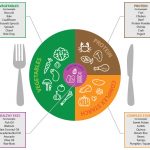How Sugar Disrupts Your Eating Cycle by Joan Kent, PhD
The Natural Eating Cycle is simple and straightforward: We feel hungry. We eat. Hunger ends. We stop eating and lose interest in food.
Those 4 steps form a continual, ongoing process. Eating this natural way is primal and elemental. Infants are experts at it, although of course a parent or caretaker feeds them.
Infants do have that last step down cold, though. Have you ever tried to feed one who’s not hungry anymore? Good luck.
That’s how it’s supposed to be. Yet the natural eating cycle can go wrong – and sugar is one reason it can happen.
Unnatural Eating Patterns
Some unnatural eating patterns may feel out of control: bingeing, extremely rapid eating, eating a lot of food when not hungry.
Others are within our control: restriction (dieting, fasting), irregular meal timing (skipping meals, grazing all day), purging (self-induced vomiting, laxative abuse, excessive exercise). And I do recognize that there may be an out-of-control element to some of these, as well, such as grazing all day or purging.
I recall 2 articles on disturbed eating. According to one article, it’s emotion-based. An event disturbs our equilibrium. We eat. We feel fat and resolve to diet.
The second article blamed dieting: We diet. We feel deprived. We binge.
What if we put the two patterns together and see how the steps interact?
1. An event disturbs our equilibrium.
2. We eat.
3. We feel fat and resolve to diet.
4. We diet.
5. We feel deprived.
6. We binge.
The 6 steps create a recognizable pattern. Based on my clinical experience, though, I’d say there’s more. Here are a few ways it might go.
Story A
We go through Steps 1-6. Bingeing (Step 6) is the event that disturbs our equilibrium, and we eat in response. We cycle through Steps 1-6, maybe over and over.
Story B
We go through steps 1-6. After bingeing (Step 6), we circle back to Step 3 – we feel fat and resolve to diet. From there, we cycle through Steps 3-6, maybe over and over.
Story C
This one involves Steps 1-3 only. Resolving to diet (Step 3) – anticipating the stress of dieting and deprivation – is enough to disturb our equilibrium, so we eat. Someone could cycle through Steps 1-3 over and over.
Sugar Makes the 3 Stories More Likely
We might feel deprived (Step 5) because we gave up sugar for the “diet,” and our sugar cravings make us binge.
We might feel stressed from anticipating a diet (Step 3). It means giving up sugar and going through the discomfort of withdrawal. We then cycle through Steps 1-3 or Steps 1-6.
But significantly, eating sugar regularly may make Step 1 occur frequently. We feel more disturbed by more events.
The effects of sugar on brain chemistry can make it difficult for some people to maintain equilibrium. Almost any stage of sugar addiction – including withdrawal – can make our eating behaviors and other behaviors more impulsive and tough to control.
The natural eating cycle is a delicate balance that’s disrupted relatively easily. Eating sugar can disrupt it a lot more.
Do you experience out-of-control eating patterns? Nutrition coaching from an expert in sugar addiction may be the perfect solution. I’m dedicated to helping you transform your health, feel better, look better, lose the mood swings, and gain control.
Just visit www.LastResortNutrition.com to schedule your Empowered Eating Consult. Find out how easy it can be to move past the eating cycles that have kept you feeling trapped.



